|
PAINTBALL HISTORY
THE ONGOING HISTORY
OF PAINTBALL
How paintball started, and the timeline of paintball guns / markers and equipment.
|
|
|
Who invented Paintball? Well there are a couple of people that made it all happen, and there is a lot more detail as you
read down the page, but this is the question most people want to know... who invented paintball? Well it's four people, and arguments
can be made for each of them. creator of paintball
Charles Nelson: The idea of a gun that shot balls of paint was his idea. I think if Bob Gurnsey, Hayes Noel, and
Charles Gaines hadn't bought that Nelspot 007 and organized the very first game of paintball, someone else eventually would have done
something similar. There are stories of ranchers and forestry workers shooting them at each other, but none of the stories are verified.
Charles Gaines, Hayes Noel and Bob Gurnsey: These three guys saw guns that were used to mark trees and cattle and figured that
they would work to see who could survive a survival game. The game they played sure wasn't the game we play today but it was the first
organized recorded game with people shooting paintballs at each other.
Bob Gurnsey: He marketed paintball as a game of capture the flag with teams using the cattle marking pistols, this is the start of
what we play now a team game of bush ball playing capture the flag. Founding National Survival Games (NSG) he had the first paintball
guns created specifically for this new game.
Not on the list.... James Hale: He didn't have the idea for a gun to shoot paintballs, he didn't even design or build the first paintball gun.
James Hales is still an important and valuable part of paintball history, after all it's his design of paintball gun that Gurnsey, Noel and
Gaines used in the first game. But he wasn't first, so he's not on the the who invented paintball list.
Early 1960s
The Nelson Paint Company was
founded in 1940 by
Charles and Evan Nelson.
Nelson had patented a
number of devices that foresters could use to mark timber.
 One of those was
a squirt gun that sprayed paint.
But the paintball was invented because the
Nelson Paint Company was asked
by the US Forestry Service for a reliable way of marking trees from a
distance. The problem
was the tree was
sometimes across a stream or thick brush. The idea behind paintballs was
that they could shoot them out over the obstruction, and a ball from a gun
would shoot farther than a stream of paint. Or ranchers could also use the
balls to mark stray cattle.
Charles Nelson played around with the idea and invented a paint pellet that
could be shot out of a gun. It was
actually created by
squirting paint into
gelatin capsules normally used then for horse pills.
Nelson
Paint then approached Crossman to design a pistol to shoot the paintballs,
after 3 years of production with poor sales. Crossman no longer found it
financially sound to produce the marker. Nelson then moved to Daisy, the airgun manufacturer to produce a paintball pistol. Obviously not owning the
design of the Crossman 707, Nelson was not able to simply pass the design to
another manufacturer, a new design needed to be created instead. Which is
exactly what Daisy did James Hale the Daisy designer created the
'Splotchmarker' which became known as the now famous 'Nel-Spot
007' The
paintballs were also mass produced. Under contract by Nelson,
RP Scherer produced the
encapsulate oil based paintballs for the makers. One of those was
a squirt gun that sprayed paint.
But the paintball was invented because the
Nelson Paint Company was asked
by the US Forestry Service for a reliable way of marking trees from a
distance. The problem
was the tree was
sometimes across a stream or thick brush. The idea behind paintballs was
that they could shoot them out over the obstruction, and a ball from a gun
would shoot farther than a stream of paint. Or ranchers could also use the
balls to mark stray cattle.
Charles Nelson played around with the idea and invented a paint pellet that
could be shot out of a gun. It was
actually created by
squirting paint into
gelatin capsules normally used then for horse pills.
Nelson
Paint then approached Crossman to design a pistol to shoot the paintballs,
after 3 years of production with poor sales. Crossman no longer found it
financially sound to produce the marker. Nelson then moved to Daisy, the airgun manufacturer to produce a paintball pistol. Obviously not owning the
design of the Crossman 707, Nelson was not able to simply pass the design to
another manufacturer, a new design needed to be created instead. Which is
exactly what Daisy did James Hale the Daisy designer created the
'Splotchmarker' which became known as the now famous 'Nel-Spot
007' The
paintballs were also mass produced. Under contract by Nelson,
RP Scherer produced the
encapsulate oil based paintballs for the makers.
1965
Crossman produced the FIRST ever paintball marker
The Nelspot 707, for
the Nelson Paintball Company. Using an
existing design of a current pellet gun the Crossman 150, now
similar to the
Crossman 2240. Unfortunately we don't know
who designed
it and there
was no new
patents with the design. Crossman originally patent the stacked tube (which
has become on the most popular types of paintball gun) in 1921 (Patents only
last approximately 25 years). And the
firing mechanism was the same as the pellet gun it was derived from.
Click on link for more information on the Crossman / Nel-Spot 707.
The Gun is
Blued steel
and was only
manufactured
for 3 years. Crossman
declined to continue producing the marker, finding it not financially
feasible to do so. The earliest ads I could find for the Nelspot 707
were found
in Western
conservation
journal:
Volume 22
1965; The
Northern
logger and
timber
processor:
Volume 14;
Canada
lumberman:
Volume 85;
all the ads referring to
the Nelspot
707 as a new
product for
forestry
workers to
mark cattle.


At top the Crossman / Nelspot 707 Paintball Gun, A pair representing the FIRST EVER
beneath it is the Crossman 150 .22 Pellet gun Paintball Gun
thanks to
Bacci
Paintball
www.baccipaintball.com
Notice
the identical grip, trigger and lower tube.
1972
Daisy
Manufacturing Company
patented and manufactured the SECOND paintball marker the
Daisy 'Splotchmarker', which Nelson marketed as the
famous 'Nel-Spot 007'. This
marker is important because it is THE marker that was used for that first
ever game of paintball in June 1981. The 'invention' of the
"paintball gun" is
sometimes mistakenly credited to James Hale because of a patent (US
3,788,298) filed for "compressed gas gun with trigger operated hammer
release latching structure" in 1972 by James C Hale of the Victor
Comptometer Corporation.
Daisy Manufacturing Company,
the airgun manufacturer, was owned by Victor Comptometer who's primary
business was making adding machines, and early calculators. Notice that the
patent is not for a compressed gas gun that fires paint pellets. The patent
was filed because the Daisy 'Splotchmarker' was designed from the ground up to
shoot a paintball, not modified from a previous air gun design. Because of
this fresh approach to design it featured a different valve, hammer, trigger
design than any existing pellet, bb, and the CROSSMAN 707, so was patented.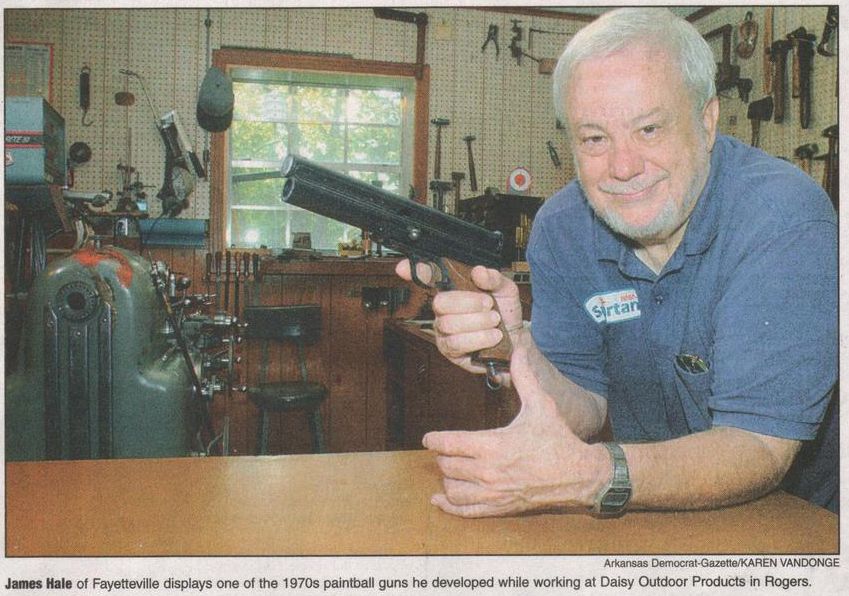
Hale said his bosses handed the job to
him. It wasn’t a particularly glamorous project, he recalled, or one that
Daisy thought would make much money. After all, how big could the market be
for marking fallen trees and roaming cows be? He
tried using an existing model of Daisy’s air pistol. It was made for tiny BB’s, so it wasn’t a surprise that the pistol didn’t shoot paintballs hard
enough to make them burst on impact. Hale decided to design a gun from
scratch. He tried different designs, but nothing worked. His heart wasn’t in
it. Daisy was a day job that he worked as he saved money to start his own
business.
Hale graduated from the University of Arkansas at Fayetteville as a
mechanical engineer. He went to Colorado and worked for Beech Aircraft Corp.
designing hydrogen fuel tanks to be used in the Apollo space missions. In
1970, He and his wife decided to move back to Arkansas in search of the
quiet life. There wasn’t a smorgasbord of engineering jobs in the area, he
recalled. While Daisy was a fun place to work, he yearned to do something
more challenging. The key innovations Hale produced that Christmas Eve 1971 were
a simplified mechanism to load the chamber and cock the gun and a set of
hollow tubes that delivered compressed carbon dioxide directly to the
paintball when fired.
The patent for Hale’s paintball gun was registered June 19, 1972, with
Hale’s name listed as the inventor. But the Daisy company owned rights to
the device since Hale developed it on company time. (Pretty common,
employment contracts give financial rights to the company on all inventions
created on company time)
Hale said Nelson contacted him in the mid-1980s and told him people were
using the paintball gun for sport. Hale’s mind instantly returned to the
days when he tested the gun by shooting pellets at a wall in the Daisy
factory to see if they would explode.
"I can remember the smack of those things hitting the wall and pitying
the poor cows that might be hit with it," Hale said. "We never imagined that
people would ever shoot each other with it."
For
James Hale, there is just the framed patent of his paintgun in his tool
shop. He said he never got involved in the paintball industry after leaving
Daisy.
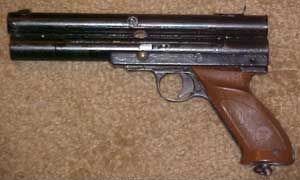

Stock Nelspot 007
Early 1975 Nelspot 007 - APG/Roy
E. Hardy of Oregon
note the brass bead ended cocking knob
May, 1976-77
It was either in the spring of
1976 or 1977, Hayes Noel (a Wallstreet stockbroker) and Charles Gaines (a
writer -
"Stay
Hungry" and
"Pumping
Iron") were drinking gin and talking,
when they thought it would be fun to start some type of stalking game, as a
challenge to their friends. They were wondering if being able to survive in
the woods is a product of environment or deeply buried instinct. In other
words does
the success
of a person
in business
or writing
or
manufacturing
or any other
business
translate
into being
able to
survive in
the woods
better than
someone who
specifically
hunted or
was a
soldier? A
friend, George
Butler saw a Nelspot in a farm catalogue. Bob Guernsey (a ski shop owner) and Hayes Noel wrote
up the rules for that first game.

Hayes Noel and Charles Gaines and Bob Gurnsey
May, 1981
Paintball
begins in Henniker, New Hampshire. The principal creators, Bob Gurnsey,
Hayes Noel, and Charles Gaines, discuss the idea
of finally having their game.
The argument had went on for a few years. The Nel-Spot marker was located
and tested on a volunteer, Shelby, Charles son, who said it didn't hurt much.
The
invitations
for the
first game
drew 9
people, plus
Bob,
Charles, and
Hayes. The 9
each paid
$175 each to
cover
equipment
costs, and
incidentals
such as food
and adult
beverages.
June 27, 1981
The first paintball players. The first game is played with 12 players competing against each other with Nel-Spot 007s pistols.
They arrived at
Charles house the day before: "Bob Jones, a novelist, staff writer for
Sports Illustrated and an experienced hunter; Ronnie Simpkins, a farmer from
Alabama and a master turkey hunter; Jerome Gary, a New York film producer;
Carl Sandquist, a New Hampshire contracting estimator; Ritchie White, the
New Hampshire forester who had told Hayes he could cut his neck in the
woods; Ken Barrett, a New York venture
capitalist with lots of hunting experience; Joe Drinon, a stock-broker from
New Hampshire and a
Ronnie Simpkins, a farmer from
Alabama and a master turkey hunter; Jerome Gary, a New York film producer;
Carl Sandquist, a New Hampshire contracting estimator; Ritchie White, the
New Hampshire forester who had told Hayes he could cut his neck in the
woods; Ken Barrett, a New York venture
capitalist with lots of hunting experience; Joe Drinon, a stock-broker from
New Hampshire and a
former Golden Gloves boxer; Bob Carlson, a trauma
surgeon from Alabama and a hunter; and myself [Lionel Atwill], a writer for
Sports Afield, a hunter and a Vietnam vet, who had had the unpleasurable
experience of leading reconnaissance missions in Vietnam in 1968, a
decidedly poor year."
The prediction the night before the game? That the hunters would do well,
and that the city boys were worth less than a case of beer. Atwill had the
most respect due to his Special Forces experience.
In alphabetical
order the players were: Linoel Atwill, Ken Barrett, Bob Carlson, Joe Drindon,
Charles Gaines, Jerome Gary, Bob Gurnsey, Bob Jones, Hayes Noel, Carl
Sandquist, Ronnie Simkins and Ritchie White. (Possibly Gaines' son, Shelby
played too, he was present.)
The game was capture the flag on an 80 acre cross-country ski area filled
with second growth woods. There were 4 flag stations, each with 12 flags of
the same colour, one for each person playing. At 10am the game started with
players equal distance apart around the field, and each flag station
had a REF with a whistle. the Refs blew their whistle every 15 minutes so
players with poorer map reading skills would be able to find the flags.
In summary, the
first player to die was Barrett. He
surrendered to Gary. Simpkins hand marked Gurnsey. Dr. Carlson shot five
people, one being Noel when Noel had three flags and was headed for a
fourth. Atwill "hurled a moldy onion" at Gaines, charged and tagged Gaines
in the leg--but the ball bounced off. The tables turned, and Gaines tagged
Atwill.
The winner? Ritchie White, the New Hampshire forester. "No one ever saw
Ritchie, and he never fired a shot. He crept through the woods from station
to station, gathering flags as easily as a schoolgirl gathers flowers."
Atwill wrote, "The play was less than spectacular compared to some Games
I've seen since, but there was a spirit to that first Game that will be hard
to capture again. The weekend bubbled with humor, honor, fun and obnoxiously
friendly, yet intense, competition. Those feelings, I believe, reflected the
dispositions of the founders of the Game." - from the book
"The Official Survival Game Manual" 1983
Following the
competition,
one of the
writer-participants,
Bob Jones,
wrote the
first Sports
Illustrated
piece about
the game (October
19, 1981
pg 64-68); later
other
articles
were
published
Time
Magazine
July 19,
1982,
and an
article in
Sports
Afield
reflecting
the
unbelievable
adrenaline
rush that
accompanied
the hunt.
Each article
was met by
an
overwhelming
number of
letters from
readers
requesting
instructions
on how they,
too, could
play. Bob Gurnsey with
the help of
Gaines and
Hayes
responded by
selling a
starter kit
that
included a
Nel-Spot
pistol,
paintballs,
a compass,
goggles and
a rule book.
They called
their
creation the
National
Survival
Game "NSG".
October 1981
the second game of
paintball,
according to
Bob Gurnsey
and NSG this
game took
place in
Alabama, and
must have
been the
first game
opened to
the general
public.
Gurnsey says
"the sport
instantly
tripled in
size"
 March
1982
The Worlds
first
commercial
paintball
field was
opened by
Bob Gurnsey
in New
Hampshire, Bob Gurnsey invented
and marketed paintball as the game we play today
under the
brand name
of National Survival Game (NSG),
or "The
Survival
Game". The
National
Survival
Game entered
into a
contract
with Nelson
Paint
Company to
be the sole
distributor
of their
paintball
equipment.
Thereafter,
they
licensed to
franchisees
in other
states the
right to
sell their
guns, paint,
and goggles.
As a result
of their
monopoly on
equipment,
they turned
a profit in
only six
months. March
1982
The Worlds
first
commercial
paintball
field was
opened by
Bob Gurnsey
in New
Hampshire, Bob Gurnsey invented
and marketed paintball as the game we play today
under the
brand name
of National Survival Game (NSG),
or "The
Survival
Game". The
National
Survival
Game entered
into a
contract
with Nelson
Paint
Company to
be the sole
distributor
of their
paintball
equipment.
Thereafter,
they
licensed to
franchisees
in other
states the
right to
sell their
guns, paint,
and goggles.
As a result
of their
monopoly on
equipment,
they turned
a profit in
only six
months.
April 1982
Caleb Strong opens the first outdoor playing field in
Rochester New York (with PMI supplied equipment? can't be the first outdoor,
gurnsey's
new hapshire
field was a
month
earlier -
still
checking if
this was the
first PMI
field, as I
suspect).
Also in April 1982
the first
franchise
NSG field
(not run by
Gurnsey
himself)
opens in
Oklahoma.
Also in April 1982
PMI
(Pursuit Marketing Inc.),
was founded by Jeff Perlmutter and David Freeman. The founders
had tried paintball and thought is was a winning idea, after unsuccessfully
trying to deal with NSG, PMI felt they could do a better job on their own.
There was no brand recognition to NSG yet, so PMI created a competing
business, where PMI created partnerships with new field owners, who would
set up the first paintball parks and then be their suppliers of the
equipment they needed. PMI never dealt directly with the customer instead
they had dealers and stores to sell their product. For their first marker
they went to the Benjamin Sheridan Air Rifle Company, who had a reputation
for being the highest quality air gun manufacturer in the United States, and
had them manufacture, exclusively for
PMI, a paintball marker for commercial use that was very durable and
reliable. The PMI-1 was the result, very similar to the later marketed
Sheridan P68sc stock class marker.
 

Also in 1982
Paintball went international when one of the first group
of NSG paintball fields opened is in Canada - London Ontario by Steve Ingles


Click on the Pictures for more
information about London Ontario History
1983
The first NSG National Championship was held in Grantham New Hampshire at a
up-country
farm and
restaurant
called Gray
Ledges.
Despite the
title it was
actually an
International
Championship.
Two of the
eight teams
of twelve
people were
from Canada.
A NSG field
in Ontario
Canada, and
the other
from
Vancouver
Canada.
These eight
teams had
survived the
regional
championships,
and had
progressed
to this
point. A
capture the
flag game on
a 30 acre
patch of
forest that
became the
field of
victory for
"The Unknown Rebels"
A team from NSG London Ontario. The Prize $3000 to the winning team, and
$1000 to the
runners up
"12-Man
Jury" the
Miami team.
People Magazine
(Oct 24,
1983 pg
42-47) hailed the
Canadians as the first world champions.
Also in
1983
Sheridan
introduces
the PG (A
side tube
non pump
version of
the PGP).
People started adding pump handles to their Nelspot pumps to make recocking
easier.
Extending magazine tubes, and doing the first
modifications
to their
guns.

Nelspot 007 with after market pump handle
Sheridan PG
June, 1983
Lionel Atwill, one of the original 12 players, writes "The Official Survival Game Manual" - the first paintball publication.
1983/1984
Lou “Gramps”
Grubb
introduced
constant air
also known
as CA, or
“California
Style
Constant
Air” to
the game.
(Instead of
little
disposable
12 gram
cartridges,
CA
refillable
tanks had a
valve with a
big knob and
various
fittings
that came
from the
plumbing
aisle of a
hardware
store.) Lou
"Gramps"
Grubb
and Mike
"Grizzly"
Grubb were
long time
airsmiths
and store
owners in
southern
California.
Constant Air was almost immediately banned from tournament play.
The argument was that the game was to be driven by tactics rather than guns.
Gravity feeds came out end of 1983, with 45 degree angle elbows and a PVC
pipe for the balls.
An
old school
PVC stick
feeder
can be made
easily with
some CPVC
pipe and a
90 degree
elbow. The
feed end can
also be made
with a 35mm
film
canister
with it's
lid cut to
make a one
way ball
gate for
your 10
round tubes,
it's all
cheap and
easy with a
trip to home
depot!
If you have a 1" inch feed like a Trracer
you just
need to
dremel the
90 degree
PVC joint, to
make it fit.


Old School Paintball, note the oil can loader
and CA Crossman 3357
1984
The sport is introduced to Australia under the name of Skirmish Games.
Also this year the NSG Splatmaster was the First
successful mass produced paintball specific marker produced solely for the sport
of paintball. Prior to the Splatmaster,
markers were adapted for use in paintball, or borrowed from other applications.
Manufactured and Marketed by "The Survival Game" also known as "National
Survival Games" or NSG. Another competitor of the Splatmaster was the
Mark-4 produced specifically for paintball and quite successful but not
marketed by NSG.

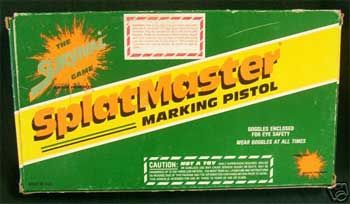
Splatmaster
Also in
1984
Barrel extenders became the next big thing, turning the compact handguns
into a rifle, cleaning kits and harnesses also came out.
Caleb Strong of Buffalo New York opened the first indoor paintball field.
Sheridan
introduces
the PGP
adding the
pump handle
to their
PG's.

Sheridan PGP
1985 The first outdoor playing field is opened in
England.
Fields started to change, getting smaller, the field owners were eager
to change
from the 100
acre games
lasting 2
hours and
low paint
volumes, to
faster games
on smaller
fields.

APG/Debra
Dion
Krischke.
MID 1980s
Silencers
start to
appear, home
made
silencers
from PVC
tube really
worked.
Eventually
companies
started to
build and
sell
silencers as
well, but
the home
made worked
just as
well. The
paintball
sniper is
truly born!
(See Mid
1990s for
ATF's word
on
silencers)

A typical
Sheridan
pump gun mid
80s, with
working
silencer!
|
1986
Dennis
Tippmann,
Sr. founds
Tippmann
Pneumatics.
Originally a
manufacturer
of
collectible,
half-scale
replica
machine
guns,
family-owned
Tippmann
entered the
paintball
industry in
1986 when
gun law
changes
forced them
to
re-evaluate
their
business.
Their first
paintball
product introduced the first full auto paintball
maker you could buy (The SMG-60 came out back in 1986 but was originally
full-auto
only.
Not
select
fire.
The
select-fire
started
at
the
2nd
generation
of
SMG
with
the
Internal
line.
As
the
external
line
was
the
first
style.)
- The Tippmann SMG-60 a .62 caliber fully automatic
featuring a side feed using a 'stripper clip' held in a magazine out the
side of the marker and used the newly introduced CA or constant air tanks
that had just been introduced this year. Other semis had been made from
converted pump guns, and other manufacturers had working models, but this
was the first to the market This marker was later converted to standard .68
caliber in the SMG-68
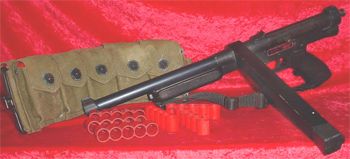
SMG-68
|
 |
LATE 80's
Tippmann
invents the Pin Valve for CO2 tanks, they decide it is in the best interest
of the sport not to patent the idea, thereby promoting it's acceptance as
the standard. And because it is much safer than the home built alternatives
that were in use at the time.
1987
Marked the advent of "Action Pursuit Games",
a feature format magazine about paintball and laser tag. Also that year, the
first commercial video about paintball, entitled "The Winning Game", is filmed
and released.
January of this year Nelson paintball's George A Skogg was grated a patent for the
first washable paintballs (No more Oil based paint, that had to be washed
out with turpentine.)
Also in 1987
was the
introduction
of barrel
plugs


APG 1st Cover
1988 APG ad Splatmaster Rapide
Also in 1987
Bud Orr
starts
making the
sniper
paintball
gun.
The design
will be
familiar to
autococker
fans, as
this is the
original
design
 that
Bud Orr
started
making in
his garage.
Later the
front pump
was replaced
with a four
way vavle,
to auto cock
the marker. that
Bud Orr
started
making in
his garage.
Later the
front pump
was replaced
with a four
way vavle,
to auto cock
the marker.
1988
IPPA (International Paintball Players Association) is founded as a
non-profit association dedicated to the education, growth and safety of the sport of paintball.
Russ
Maynard,
founding
editor of
APG, led the
way toward
establishing
the speed
limit of 300
fps. At the
International
Paintball
Players
Association
(IPPA) in
1988, 300
fps was
standardized
as the
maximum
speed limit.
It is the
worldwide
limit on how
fast a
paintball
leaves the
marker, and
is now in the
ASTM
standards
for
paintball. Also
in 1988
Speedball makes its debut at Sat Cong Village, a paintball field in Southern
California. Also called "arena ball", this revolutionary new variation of the
game
Early Model
1987 Sniper
I marker
is an instant hit and was soon being played at paintball fields all around
the globe. And Pro-Star Labs, Inc. introduces the "Bouncing Betty" paint
grenade. Straight shot Inc introduced the 'Straight Shot Squeegee"
MAY 2 1988
Top Gun Paintball Games' owner, Raymond Gong, founded
and legalized paintball in New Jersey on May 2, 1988. Prior to
winning his lawsuit, paintball play was considered illegal in New Jersey. The NJ State Police, considered paintball guns to be firearms. Even if a
player followed all the firearm rules for the purchase or ownership of the
paintball gun, it could be considered Assault and Battery if the "firearm"
was discharged at another player. Any would-be paintball player in New
Jersey ran the risk of being arrested. New Jersey was the last state to
legalize paintball. (Read the rest of the story by clicking on the
underlined text above.)
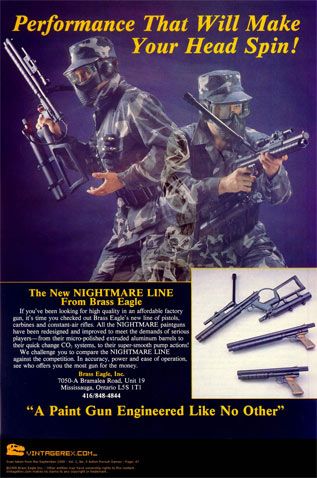 
November
1989
- 20 year
old, Gino
Postorivo
started
National
Paintball
Supply as a
small retail
operation
out of the
pizzeria's
back room.
It began
with $1,000
from his own
pocket. Unlike
many
paintball
supply
companies,
Johnny
Postorivo (NPS'
chief
operating
officer and
Gino's
cousin) said
NPS is not
hung up on
exclusive
deals with
the brands
it carries.
"Everybody
has
proprietary
items. Me,
I'll buy
anything
someone will
sell to me,"
Johnny
Postorivo
said, adding
that he
views it as
an advantage
because all
brands can
be found in
the
showroom.
1990
-
The first national tournament to allow 12 gram and constant air is held in Nashville. The tournament, called the Music City Open, is
also the first national tournament to allow carry-on paint and the first major
event to be sanctioned by the I.P.P.A.

APG ad June 1988
1991
Tom Kaye
(the
inventor of the Automag)
and the staff at Air Gun Designs developed the first nitrogen system for
paintball along with fiberglass tanks. It was not marketed, as the industry
felt high pressure nitrogen was simply too dangerous. Today however, it's
hard to find players in large tournaments still running CO2. Tom refused to
patent the regulated nitrogen system for the sake of the sport, since he
felt it was a superior power source over CO2.
Also in 1991
Paintball begins in France, Denmark and other countries in Europe
Mid 1991
-
Bud Orr
introduces
the
Autococker,
first as an
add on kit
for his
successful
pump gun the
sniper and
sniper II,
but soon
following
with
complete
markers in
early 1992.
(Bud makes
claims that
this was '89
in
interviews,
but this is
chalked up
to a
memory slip.) The
Autococker
became
commonly
available as
a complete
gun in 1992.
1992 Arthur
Chang forms
Kingman
International
Corp. with
the vision
"to offer a
superior
product at
an
affordable
price. That
philosophy
has pushed
Kingman to
consistently
raise the
standards in
paintball
product
design and
innovation."
Starting
with the
'HAMMER' a
nelson based
pump, and
followed by
the 'HAMMER
A' in
1993,
similar to
the TRRACER
pump, but
with an
aluminum
frame. Their first
in-house
designed marker is
released two
years later
in 1994, the
amazingly
successful Kingman Spyder
April 15, 1992
Rec.sport.paintball passes its vote for creation on a vote of 195 to 43 and is announced as an official newsgroup.
Sheridan VM-68 / PMI - 3 introduced, one of the early very popular semi
automatic guns. A prototype had been used in 1990 at a tournament
 
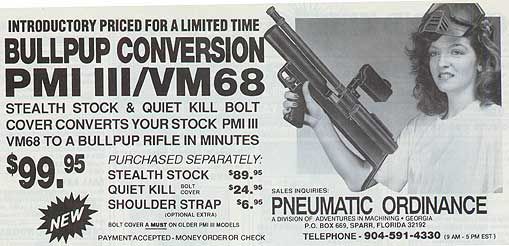
  July, 1992
Team Internet is formed as
players prepared for the World Record
Game (billed
as the
"world's
largest
paintball
game"at Jack Frost Mountain, PA. July, 1992
Team Internet is formed as
players prepared for the World Record
Game (billed
as the
"world's
largest
paintball
game"at Jack Frost Mountain, PA.
November, 1992
NPPL (National Professional Paintball League) is founded in Chicago and the NPPL Pro-Am Series starts with events around the US.
1994 Steve
Mitchell
creates
Warpig (www.warpig.com) the first internet paintball site.
Also in 1994
Kingman
International
introduces
the spyder
series of
markers.

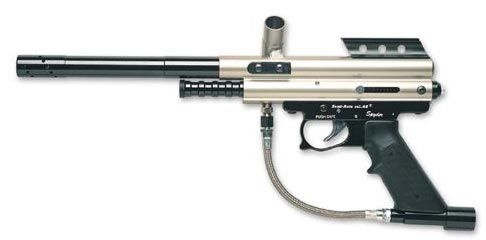
Kingman
Spyder
Classic
1995
Paintball makes its
cable TV debut on E.S.P.N. with the airing of the 1995
World Championship Games
held in Orlando, Florida. Later that year, in television newscasts all across
America, a videotape of four teenagers using paintball guns in a drive by
shooting is aired and paintball players in every corner of the world voice their
outrage over the incident. Also paintball fields are opened in Europe, Asia, and South America.
Also in 1995
Brass Eagle
owned by
Aldo Perone
Toronto
(currently
XO
industries,
Skyball),
sold Brass
Eagle to
Daisy
Manufacturing
Co.
MID
1990s
The ATF
makes a
decision
about
paintball
silencers,
they are now
illegal,
they have
decided that
they are
able to
silence real
firearms, so
are illegal
to posses
1996
Paintball playing fields, stores and tournaments can now be found in Canada, the United States, Australia, England, Scotland, Denmark, France, Holland, Germany, Austria, Ireland, Belgium, Greece, Italy, Norway, Sweden, Africa, Russia, New Zealand, Brazil, Venezuela, Israel, Korea, Thailand and the Philippines.
 |
Also
in 1996
the Shocker, manufactured by PneuVentures Inc., and distributed exclusively
by Smart
Parts
(patent Oct
19, 1999) is
the first electroneumatic
paintball marker, PneuVentures and Smart Parts soon parted with PneuVentures
in 1997
producing
the Shocker,
and PneuVentures
producing
the very
advanced
Cyber 9000
the
first
marker
with
built
in
LCD
screen,
also
featuring
built
in
chronograph!

|
1997
Brass Eagle Large enough to split
from parent
company
Daisy
|
Also in 1997
The WDP
Angel V6 was
introduced
as a
prototype at
the 1997 Zap
International
Amateur Open.
Though
argued as
the first
electroneumatic,
they were a
over a year
behind, and
several
years behind
getting to
the patent
office.
|
|

WDP Angel V6 |
1998
First Agitated paintball hopper patented
Also in 1998
Big chain
stores like WAL-MART, started carrying
Paintball. First it was low end Brass Eagle like the Blade, Tiger Shark,
Samurai. Standard equipment on these markers were 12gram adapters, and 40
round AMMO BOX loaders, behind the times with the magazines and the local
paintball stores to be sure but soon the higher end Brass Eagle was
available like the
RainMaker (an early inexpensive electro-pneumatic marker
designed by
Nick Lotacko,
designer of
the Vector
for Air
Power) Prices were high
and quality
was low, but
it was a
start to
getting
paintball
from an
obscure
sport nobody
knew to one
that people
had at least
heard of.
Also in 1998
Tippmann introduces the
model 98
paintball
marker.
1999
-
Concerns regarding paintball guns and rate-of-fire spark another major debate,
ultimately leading to a decision to limit the b.p.s. (balls-per-second) of any
gun manufactured from the year 2000 on.
Jan 1999
Brass Eagle buys Viewloader from CM Support
(Dave and
Rhoda Bell)
2001
The last
year for the Sheridan PGP, the 2001 was a slick stock handgun used as a
backup gun, it is one of the few stock class markers to survive in the mainstream
paintball stores amongst the semi automatics. (Phantoms and others continue,
but few people buy 'stock' makers without specifically playing stock class)
Also this year due to the Sept 11th terrorist attacks, there is a real push
to change 'paintball GUN' to 'paintball MARKER' as the
politically correct fad spreads, the word 'guns' bring negative publicity
where marker is 'safe' and 'sport' There is a real push to be aware of
paintball's image as the sport becomes more popular.
Also this year Smart Parts introduces the ON/Off tank valve.
Also in 2001
NPPL
requires
Barrel Bags
instead of
Barrel
Plugs, first
referred to
as Barrel
condoms, now
commonly
known as BBD
(Barrel
blocking
Device) The
change was
due to two
reasons, the
bag was far
easier to
see,
tournament
players were
commonly not
using plugs,
or getting
plugs made
of metal the
same color
as their
barrel,
making it
hard for
refs. Second
the bags are
able to
handle
multiple
shots that
could occur
from
tournament
electro
makers with
very light
triggers,
that would
blow the
barrel plugs
out.


PGP 2000 aka 2k1
Game Face
Paintball is
created as a
joint
venture of
Crossman
Corporation/Sheridan,
and leading
paintball
manufacturer Procaps
Inc. known
for the DraXxus
paintball
brand.
March 2002
Brass Eagle announces that they are acquiring
JTUSA from owners John and Rita Gregory
April
2002
National
Paintball
Supply (NPS)
completes
acquisition
of Diablo
Direct,
Diablo is
not the only
brand NPS
has bought.
It also owns
Unique,
Psychoballistics,
Empire and
32 Degrees.

Aug 2002 Richmond Italia
starts
the NXL (National X Ball League) It's a new format of speedball paintball,
designed for TV, Two 5-man teams go at
it in a center-flag format game. They get a point for hanging the flag, and
then go at it again, with a constantly running game clock the game ends when
the clock runs out. Instead of just pulling players for penalties, the
offenders would serve time in a penalty box, much like in hockey, so a team
could come back after a flag hang and start one or more players short
It recruits a lot of speedball players from NPPL and PSP leagues and demands
that they play exclusively for NXL events.
NOV 2002
DURTY DAN,
one of the greats of paintball knowledge, and a great Canadian player closes
his site. The last version of it is archived here. 
Richmond Italia
2003
Big news
from Smart Parts as they drastically reduce the size and air usage on their
top tournament marker. The 'Shocker', but
Smart Parts backlash
from
paintball
players
begin -Smart
Parts has
been
applying for
new patents
on existing
designs, and
threatened
lawsuits
against
companies
such as PMI,
Planet
Eclipse, Indian Creek Design,
DYE Precision, Inc.
and
others who build
markers with an "electro-pneumatic valve to operate a bolt assembly" to
which Smart Parts owns a patent. Patent agreements are signed as companies
loose lawsuits or agree to pay license fees.
The players see it as Big brother style control, and a grab for money by
Smart Parts. See
article for more examples of why people
feel this way. Interestingly two individuals currently associated with Smart
Parts were
involved in
an
"invention
submission"
business,
offering to
patent
ideas, then
charging
huge fees to
have it
marketed.
The Federal
Trade
Commission
shut it down
for
"deceptive
practices".
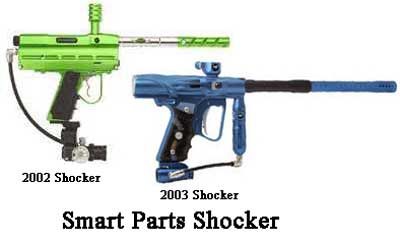

Tippmann Introduces the FLATLINE barrel, back spin on the paintball produces
a flatter trajectory and able to shoot 80ft-100ft further! Lots of
controversy on this, does it break that far out? And snide comments about
the banana barrel shape. But it really works!
In the paintball magazines, there is a huge focus on speedball. Although
less than 2% of paintball players play speedball, it is the focus because
it's considered the more politically correct image of paintball. Bushball,
with the camo and army tactics is considered bad press in a post 9/11 world.
There is also a major shift from CO2 to HPA/N2 tanks, prices are
dropping, the speedball centered articles and advertising explains that
speedball b.p.s shooting speeds is too fast for CO2 to recharge, and Co2
users will suffer 'shoot-down' from the lack of pressure. Despite the fact
that few players are playing speedball or shooting that fast to make it
matter, the switch to HPA is increasing. It does have some benefits or
working better in cold weather, for people living in the North of North
America. But also rumours that HPA makes your marker more accurate also
circulate, (Because HPA operates at 3000+ psi and doesn't self regulate like
CO2 it requires a regulator that controls pressure. The regulator makes
better consistency not the gas, Co2 with a regulator is also just as consi stent.) stent.)
Dec
2003
K2
Sports Inc. the well known ski and
snowboard company buys Brass Eagle. K2 now owns Brass Eagle, JT, and Viewloader.
Also Dec
2003 PMI
buys
R.P.Scherer
Paintball
Manufacturing
Division
From
Cardinal
Health, Inc
2004
Greg Hastings' Tournament Paintball comes out for XBOX. It seems
paintball
has made
it to
the masses with this sleeper hit. Greg 'Red' Hastings
formerly the creator of REDz comfort packs, and current speedball player
with team XSV creates a fun fast pace game that is sure to be in every
paintball player's XBOX game collection.
APRIL 2004
K2 Sports Inc
bought out Worr Games Products (WGP). They are also the owners of other paintball
companies
Brass Eagle,
View Loader,
JT
June 24,
2004
Tippmann
Pneumatics,
Inc., has
completed a
financial
recapitalization
with Summit
Partners, a
private
equity and
venture
capital
firm. The
Tippmann
family will
continue to
have a
significant
minority
interest in
the
business.
Dennis
Tippmann,
Sr., Founder
of Tippmann,
will serve
on the
company’s
Board of
Directors
and provide
ongoing
consultation
to the
management
team as
needed.
Dennis
Tippmann,
Jr. will
also serve
on the
company’s
Board and
continue
full-time as
a member of
the senior
management
team to lead
the
company’s
product
development
effort. Mr.
Tippmann,
Sr.
commented on
the
partnership.
“...By
partnering
with Summit
Partners as
our first
professional
investor, we
can now take
our business
to the next
level and
seek
complementary
acquisitions
within the
paintball
industry to
expand our
product
offering and
market
share.” In
connection
with this
transaction,
Howard A.
Kosick has
joined
Tippmann as
President
and CEO. Mr.
Kosick has
held a
number of
senior
management
positions in
consumer
goods and
sporting
goods
companies,
including
Bell Sports,
Arctic Zone,
and Thermos.
While he was
at Bell
Sports, the
company
became the
market
leader in
bicycle
helmets and
accessories
during the
industry’s
high-growth
period in
the 1990s.
In his most
recent
position as
CEO of Bell
Automotive
Products and
Bay
Travelgear,
Mr. Kosick
served the
mass
merchant,
sporting
goods, and
specialty
channels—the
primary
distribution
outlets for
Tippmann. As
part of the
recapitalization,
the company
plans to
change its
name to
Tippmann
Sports, LLC,
to better
reflect the
company’s
participation
in extreme
sports.
Late 2004
With America
at war, and
a republican
governemt,
it seems
everyone is
supporting
the troops.
This seems
to be a
contributing
factor in
the major shift, back towards Bushball and MIL-SIM (military
simulation games), sites like Special Ops Paintball, and OPS Gear make it
cool to play in the woods again. Markers by RAP4 (Real action paintball),
Tippmann, Ariakon look like M16's and M4's and MP5's more than speedball
guns. The paintball magazines respond by featuring far more bushball
and scenario game articles than they have had in years. See below for the
new look of
paintball
for
2004-2005
The
New Look of Paintball


 Special
Ops A5A2 Special
Ops A5A2
 RAP4 T68
RAP4 T68
Dec 2004
Tom Kaye
inventor of
the power
feed,
regulator,
HPA for
paintball
and designer
of the
Automag,
retired from
Air Gun
Designs
(AGD) his
Vice
President
Dave Zupan
has bought
out the
inventory
and taken over as
president
and owner of
the company.
2005
The Tippmann
C-3™ with
PEP (Propane
Enhanced
Performance)
technology
is the
world’s
first
propane
powered
paintball
marker. With
more than
50,000 shots
per 16-ounce
tank! That's
probably
less than a
tank per
season for
most
players.
Is the
bigger news
that it uses
combustion
to fire the
ball, or
that it's a
pump? A semi
auto with
PEP is
apparently
on the way.


Also 2005 Greg Hastings is back with Greg Hastings' Tournament Paintball Max'd looks like
another hit
game for the
XBOX, as the
game now
launches on
multiplatform
out to the
Playstation2.
Greg himself
has started
another
company
having left REDz he
created,
he's now
starting a
new company
R7 (his
jersey
number is
#7), also
featuring a
well built
pod pack
system with
separate
belt and
pack.
Also 2005
The bushball
revolution
continues as
Smart Parts
are getting
back into
bushball,
with their
new SP8
marker, and
bringing
back the
Renegade
line of Camo
gear. While
JT is coming
out with JT
Tactical
line of gear
and their
new Tac-5
paintball
gun.



Smart Parts
SP8
Late 2005
The
Canadian
XBall League
is founded,
bringing
XBALL style
paintball to
Canada.
There are
four
proposed
regions
across
Canada
including
Ontario,
Quebec,
Eastern and
Western
territories
Sept 2005
Tippmann,
the
manufacturer
of paintball
markers and
related
accessories,
has
purchased
Straight Shot,Inc.,
manufacturer
of the
Straight
Shot
squeegee.
 Dec
2005
National
Paintball
issues press
release
about the
EVOLT
marker.
Using it's
"power
pulse" to
fire the
marker from
it's 18volt
battery. The
marker needs
no air
source. The
Power pulse
system
reportedly
uses the
battery to
generate the
air pressure
to fire the
marker. Dec
2005
National
Paintball
issues press
release
about the
EVOLT
marker.
Using it's
"power
pulse" to
fire the
marker from
it's 18volt
battery. The
marker needs
no air
source. The
Power pulse
system
reportedly
uses the
battery to
generate the
air pressure
to fire the
marker.
The marker
turns out to
be a case of
vapourware.
The marker
never
materializes
beyond the
prototype,
and the
technology
that was
suggested
has not
materialized
in any other
makers.
 Jan 2006
Spyder
has joined
the bushball
revolution Jan 2006
Spyder
has joined
the bushball
revolution
with their new MR1 and MR2 "Military Style Markers", tactical black with
removable
stock, and
sight rail.
Available in
electro or
standard
blowback.
Feb 2006
PMI no
longer
distributing
Tippmann
products.
PMI says
lack of
margin, and
the
introduction
of their new
PCS -
Pursuit
Combat
System milsim line
of gear
(extremely
similar to
Tippmann A-5
and Tippmann
98 in this
writers
opinion)
Nov 2006
PMI and NPS
combining.
Two of the
giants in
the
paintball
business PMI
- Pursuit
Marketing
Inc, and NPS
- National
Paintball
Supply will
be joining
into one
larger
company.
Between the
two
companies
they supply
the majority
of paintball
equipment to
most stores
and fields.
PMI is such
brands, as
Piranha,
Evil, Pure
Energy
Tanks,
Extreme Rage
gear, RPS
paintballs,
and PCS
milsim gear.
NPS is
Diablo
paintballs,
Empire, 32
degrees,
Vents,
Paintball
2Xtremes
magazine,
and
distributors
of Bob Long,
and BT
Paintball
gear.
 Also
Nov 2006
Tippmann
Sports and
Special Ops
Paintball
team up to
produce the
Tippmann X7
milsim style
marker.
Designed
together,
and launched
with an
array of
customizable
parts from
Special Ops.
The X7 is being
launched in
conjunction
with more
than 30
different
integrated
mods –
making it
easy to give
the marker
thousands of
different
milsim looks. Also
Nov 2006
Tippmann
Sports and
Special Ops
Paintball
team up to
produce the
Tippmann X7
milsim style
marker.
Designed
together,
and launched
with an
array of
customizable
parts from
Special Ops.
The X7 is being
launched in
conjunction
with more
than 30
different
integrated
mods –
making it
easy to give
the marker
thousands of
different
milsim looks.
Jan 2007
AJ Holdings
LLC,
successor to
National
Paintball
Supply and
Pursuit
Marketing,
Inc, has
been renamed
KEE Action
Sports. KEE
Action
Sports will
use the
slogan
“Adrenaline
Delivered”
to emphasize
its
commitment
to providing
innovative,
high
quality,
exciting
products to
the
paintball
industry.
Feb 2007
Tippmann
Sports
sponsors
Special Ops
Paintball
Brigade.
Bringing
Special Ops
and Tippmann
closer
together
Aug 2007
K2 Inc. Has
been bought
out by
Jarden
Corporation.
That
includes all
of K2's
Paintball
subsidiaries: JT,
Brass Eagle, Viewloader,
and WORR
Games
Products. Jarden
describes
themselves
as
a leading
provider of
niche
consumer
products
used in and
around the
home.
They own
such brands
as First
Alert (smoke
alarms),
Rawlings
(baseball),
Shakespeare
(fishing
rods etc),
Bicycle
(playing
cards),
Coleman
(Camping
equipment),
Crock-pot
Sunbeam and
Mr Coffee.
Jan 2008
Indian Creek
Design is
leaving the
paintball
Business.
I n
business
since 1986
run by Jerry
Dobbins, ICD
became best
know for
their
AlleyCat,
BobCat, and
Puma
markers, and
Bushmaster
and BKO
series
markers. A
great loss
to our
sport. n
business
since 1986
run by Jerry
Dobbins, ICD
became best
know for
their
AlleyCat,
BobCat, and
Puma
markers, and
Bushmaster
and BKO
series
markers. A
great loss
to our
sport.
Oct 2008
Activision
announced
release of
NPPL
Championship
Paintball
2009 video
game for the
PS3, PS2,
XBOX360, Wii
and PC
Nov 2008
Greg
Hastings
Tournament
Paintball 2
released for
XBOX360,
Dec 2008
KEE Action
Sports LLC
and HATER
Paintball
LLC,
announce an
agreement
whereby KEE
has become
the
exclusive,
world-wide
distributor
of all HATER
electronic
products.
The license
agreement
gives KEE
access to
the most
advanced
electronic
technology
in the
paintball
industry and
provides
HATER access
to the
broadest
sales
network in
the
marketplace
though KEE.
All HATRED
marker
boards and
SYMBIO
wireless
loader
boards will
now be
obtained
directly
through KEE
Action
Sports.
Worr games
products and
the
Autococker
is no more,
faded out by
parent
company
JT/K2/Jarden,
loss of Bud
Orr at the
head of the
company, and
failing
sales
against new
electro
markers have
brought it
to an end.
Fall 2009
.50 Caliber
Paintball is
coming. Sure
there have
been a few
handguns
with .40 or
.43 other
odd sizes,
but Richmond
Italia (ProCaps
Paintballs
etc) with
Smart Parts
guys (Bill
and Adam
Gardner) are
getting in
the game
with with 50
caliber gear
they are
branding as
G.I.MILSIM
brand
which they
are tagging
Paintball
2.0, and now
KINGMANN
Spyder has
just
announced a
.50 Caliber
line of gear
at their new
site.
This author
just thinks
it's an
excuse by
equipment
makers for
everyone to
buy all new
gear, but
they claim
less money
for shipping
so cheaper
prices, less
player
fatigue, and
less impact
pain. We'll
see...
Feb 2010
KEE Action
Sports LLC.
announced
that it has
acquired the
assets of JT
Sports.
[from Jarden
subsidiary
K2],
Effective
immediately,
KEE will be
manufacturing
and selling
the entire
line of JT
Sports,
Brass Eagle,
and
ViewLoader
paintball
products.
June 2010
J. Wayne
Merck has
joined KEE
Action
Sports LLC's
board. Mr.
Merck was
most
recently
Director,
President
and CEO of
K2 Inc.
March 2011
KEE Action
Sports, LLC.
announces
today that
it has
acquired the
intellectual
property
portfolio of
Smart Parts.
KEE believes
it was
critical to
paintball
that the
portfolio
stayed
inside the
industry.
KEE’s
President
and CEO,
John
Robinson,
said that
“KEE is
committed to
growing
paintball
participation
industry-wide
and that KEE
intends to
use the
intellectual
property
assets in a
manner
consistent
with that
goal.” In a
letter to be
sent out
shortly, KEE
will inform
current
license
holders how
it intends
to continue
to work with
them under
their
current
license
arrangements.
KEE welcomes
contacts
from other
companies
interested
in pursuing
a
partnership
relating to
its new IP
assets.
LINKS
RELATED TO
PAINTBALL
HISTORY





Original
Document by Colin 'SunyJIm' Wells, 2005 some information adapted from Paul "Stryder" Kloehn's
history of paintball, "exerts from The Complete guide to paintball",
"The Official Survival Game Manual" and many many websites, that are all too
quickly disappearing. As well as patent info from
Airsoldier. SunyJim claims no rights on the pictures shown here, they
are a collection strictly for history purposes.



|